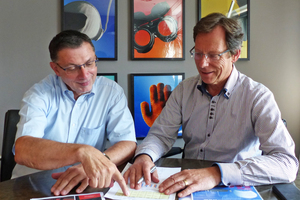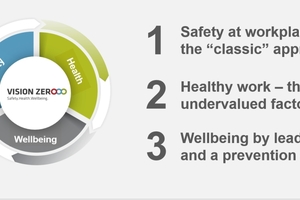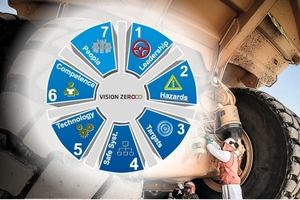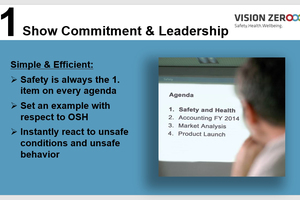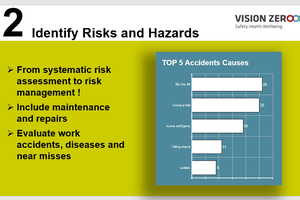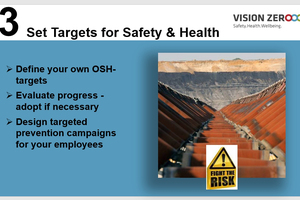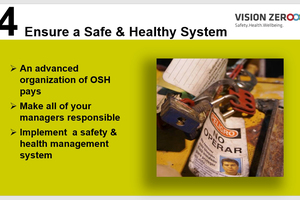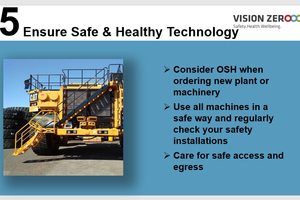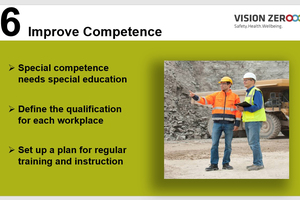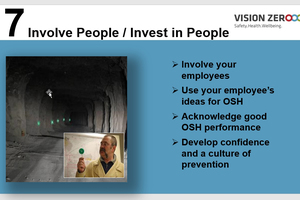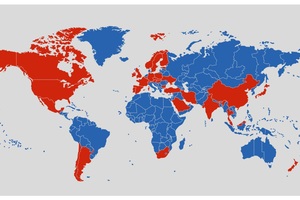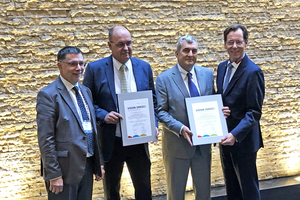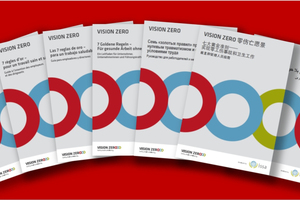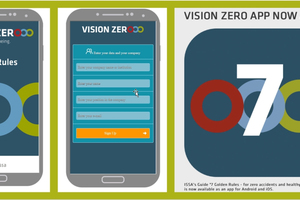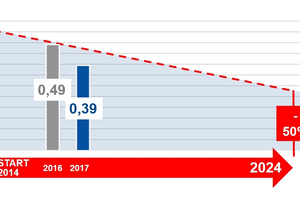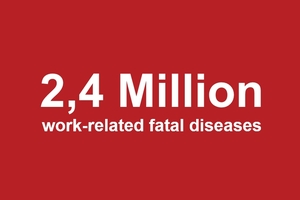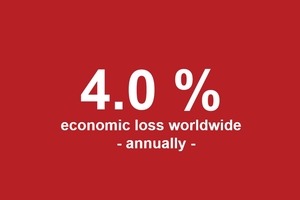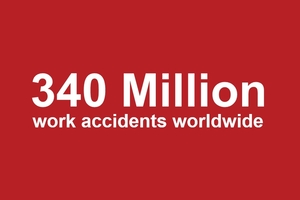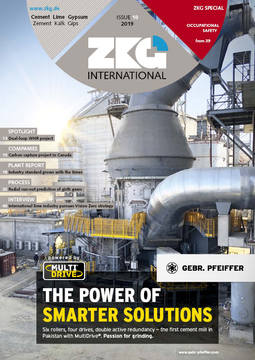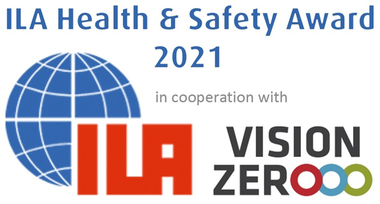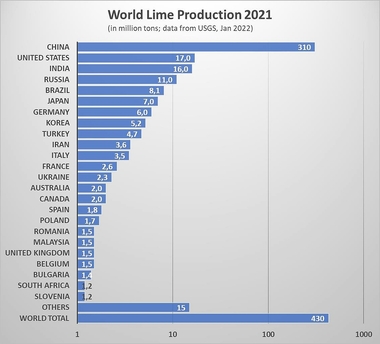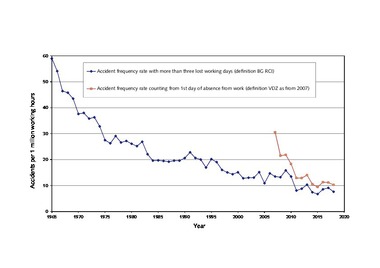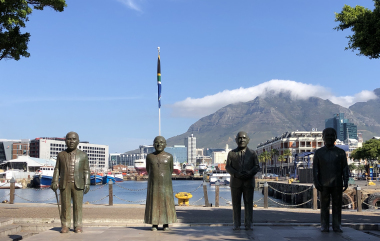International lime industry pursues Vision Zero strategy
At the International Lime Association (ILA) conference in Cape Town/South Africa in October 2018, the ILA joined the Vision Zero Initiative of the International Social Security Association (ISSA). This was the first time an entire industry organization has signed up to the initiative. Vision Zero is the vision of a world without occupational accidents and work-related illnesses. We talked to Dr. Thomas Stumpf, ILA Secretary General, and Helmut Ehnes, ISSA Mining Secretary General about what Vision Zero can do for the industry.
What exactly is VISION ZERO?
H. E.: All around the world, also in the lime industry, we still have an unsatisfactory situation with regard to occupational accidents and work-related illnesses or diseases. Every year, we have 400000 deaths due to industrial accidents worldwide, plus an estimated 2.4 million deaths from occupational illnesses. The health issue is thus the more serious of the two. The whole situation not only has a huge social component but also an economic dimension. On average, 4 % of world economic performance is lost, which amounts to a sum of US$ 3,400 billion. This money could be put to better use if more preventive safety and health measures were implemented – there is huge potential here.
Vision Zero stands for the conviction that there are always causes for every accident and occupational illness. We can prevent accidents and illnesses by finding and eliminating these causes in good time. That’s the simple message of Vision Zero. Vision Zero is therefore a strategy for a prevention culture. The aim is to change people’s attitudes, especially those of company executives, and thus initiate a cultural change. In almost every country there are enough laws, paragraphs and regulations that are unfortunately not implemented in daily life. Vision Zero, on the other hand, is a very simple approach based on common sense. With the “Seven Golden Rules” we want to create emotions, both at the management level and in all employees. Everybody must feel personally motivated to participate in this process.
T. S.: Vision Zero impresses me very much due to the practicability of the programmes and guidelines and the holistic view of people not only as employees, but in their entire environment. The initiative consistently takes into consideration that occupational health and safety belong together and do not just start at the workplace. There are many factors, also in the environment outside of the workplace, which affect the ability of people to perform well and concentrate properly. Vision Zero takes into account that the care for health and safety should not be limited to the working sector, but has to be pursued in a holistic approach in the private sector as well as by society. It is one of Vision Zero’s concerns to take a closer look at people’s health in the future and then to promote safety at work with a wide range of measures.
And this concept can be easily communicated?
H. E.: That’s right: safety and health belong together and are united in Vision Zero. It is relatively easy to realize that we cannot develop this prevention culture at the workplace alone, but that it actually has to start in the kindergarten. I find that the topic of prevention is taught far too little in schools, vocational training schools and universities. Because these are the places that produce the future skilled employees and managers. And, for this topic, we must not only inspire engineers, technicians or scientists, but also lawyers, business administration graduates – ultimately, all those who occupy executive positions. The issue is not just having engineers design protective grids, but asking yourself the question: how do I run a business and how do I lead people? And what significance do I attach to prevention? To achieve that, we at ISSA Mining are looking for a conversation with mining professors from all continents. Vision Zero has to be integrated into the training courses and that should actually be the case everywhere.
T. S.: Technical occupational safety, which is designed and constructed by engineers, is the foundation on which we build. The technical and organizational aspects of occupational safety and health has long been in the focus of the companies. More recently, however, health and safety at work has become more clearly communicated company-wide and often prioritized as a corporate goal. Thus, technical and organizational safety measures at work have received new impetus – as well as the necessary resources and investment funds.
However, Vision Zero still has to think ahead and act. We have to think beyond the aforementioned classic entrepreneurial strategies and measures. The insight is growing that in modern, flexible, dynamically or even disruptively changing companies there must be new ways of thinking. Occupational safety must go far beyond instruction packages for employees. Cognitive insight urgently needs emotional reinforcement.
We also need behaviour-oriented policies and measures in a much broader sense, with the clear goal of fundamental cultural and mental change in and beyond companies. Only in this way will the vision of accident-free operations become tangible. A very wide range of training, strategy workshops and various training measures are available in a wide variety of fields to bring about the necessary change. Trained, health-conscious employees – perhaps active in sports – will be less at risk of accidents, less prone to illnesses and disease and more resilient. Such activities promote a holistic approach to health. Building on decades of experience of the global mining industry, Vision Zero has developed a practice-oriented guide. It is available to all companies and their executives to enable the achievement of the great goal of an accident-free work environment.
Please explain the “Seven Golden Rules” of Vision Zero.
H. E.: We developed the Seven Golden Rules by once again reflecting on many decades of experience. More than 1000 people were asked: What is your experience, what do you think works and what does not? This is the origin of the Seven Golden Rules.
Rule No. 1 is: Without leadership nothing works! Company management must define what it wants, be clear about it and enforce it visibly. A popular statement on the company intranet does not help on its own; the employees have to be addressed and involved.
No. 2 asks: What hazards and risks do we have at our workplaces? This means, on the one hand, to look back and to really analyze the past accidents and illnesses, including the so-called near-misses – but also to look ahead in a proactive manner. You have to create systems of risk assessment, or better to manage the risks.
No. 3 comprises the establishment of an operational programme and the definition of individual goals at the company level.
The 4th golden rule deals with the organization, because for many things organizational prerequisites simply have to be created first. It must be clear who exactly is responsible for what. Regular training of employees and the creation of operating instructions are also part of this. Ideally, an occupational health and safety management system has been established.
The 5th factor is the technical aspect. This includes, for example: How are the systems protected, which emissions (noise, dust, etc.) occur? This aspect always has something to do with investment.
The human being is the topic of the 6th golden rule: how well are employees qualified for their work? Is further training required? In our view, this is a growth sector because the half-life of knowledge is getting shorter and shorter.
And finally, the 7th Golden Rule is once again about the human factor. You have to talk to your staff about mistakes that have happened. On the one hand, this means developing an open culture of learning through errors – and on the other, asking employees for their ideas.
These are the seven golden rules that are understood all over the world because they are very simple.
But it isn’t enough to just set up simple rules, is it?
T. S.: I can confirm that from practical experience. Step-by-step measures must follow strategic decisions. In companies, including lime industry firms, occupational safety and health are treated as a top priority and are consistently on the agenda. Frequently – also in companies’ annual reports – the aspects of health and safety are discussed right at the beginning, especially, of course, if an accident actually happened. And most importantly, measures that can lead to improvements are regularly and openly discussed and consequences are drawn. You always have to stay on the ball; it’s something that’s never finished.
H. E.: I believe that a systematic implementation of processes can provide a foundation. However, the vision of an accident-free company will not be achieved if you only do this. The belief in a systematic process comes from a time when companies were extremely hierarchically structured and foremen could, so to say, “instruct” safety. The further we develop, the more these hierarchies will break down and sometimes completely disappear. There will be more and more jobs that cannot be overseen directly, and in such cases orders and instructions will no longer produce results. Also a systematic description of work processes is not enough, we increasingly need a cultural change in the entire range of activities of the people in the company. Companies can influence the personal safety of employees, as well as their attitude towards health and welfare. Only in this way can the employees be guided to an attitude of not ever slackening in their safety thinking. The goal must be to avoid even one single accident and to significantly improve health. Safety and health must simply be a matter that is near to their hearts.
It is also important to enable people to think for themselves “How safe is what I am doing here?”. If they are not sure, they must also dare to say “stop”. They must not fear negative consequences, but should be praised for doing so. Communication with the company managers must not take place in a culture of fear, but in an open communication culture.
The managing director of a major cement producer, and member of Vision Zero, described this as follows: “Pressure is not effective; the key to success is motivation. Motivating people to act on their own initiative and not just to react to instructions. They themselves have to carry this issue of safety uppermost in their hearts and minds.” Errors should not be seen as a regrettable interruption of operations, but as a chance – a chance to get better.
How many organizations and companies worldwide have now signed up to this prevention strategy?
H. E.: All partners are listed on the Vision Zero website (http://visionzero.global). We want to persuade more and more companies to register their name and to say: I am with you, I am a partner of Vision Zero! Since September 2017 we have convinced more than 6000 partners worldwide to join the initiative. Among these partners are individual companies, but also associations like the ILA. And behind such an umbrella organization there are always a large number of companies that are not recorded individually on the website.
What does it cost to participate in Vision Zero?
H. E.: Registration on the website is free. We are very pleased if the partners also become members of ISSA Mining. The membership fee for that is 500 CHF per year. ISSA Mining is the hub for Vision Zero, which is constantly being evolved to provide partners with information and tools for use in their plants. The more active members we have, the more possibilities we have for further development.
The ILA joined the Vision Zero programme in 2018 – with what objectives?
T. S.: After all, the ILA is ultimately a platform for the compliant communication of the global lime industry regarding the extraction, production and use of our diverse products. Of course, as a world organization we have no regulatory or normative tasks. The discussion of health and safety as well as sustainability is the core of our vision and mission. Our wish is to promote the worldwide exchange of ideas and information in these areas, to present measures and “best practice”. That’s how we want bring our influence to bear globally, in order to help our member companies with their health and safety efforts.
Strategies and measures have already been developed by ISSA Mining with the project Vision Zero on the basis of worldwide knowledge. We did not see our task as developing another strategy or a new package of measures in addition to Vision Zero. We want to bring across the very good work done at Vision Zero on our ILA communication platform. Our goal is to adapt this very important topic via the membership and through information on the motivation of the world lime industry. We see ourselves as an intermediary between ISSA Mining, Vision Zero and the companies or associations that are integrated in the ILA.
Paul Ellis, President of the ILA, emphasized that the ILA will work closely with ISSA Mining to implement Vision Zero. He said that the first step would be to develop an action plan. How far are you with it?
T. S.: The action plan is in the works and we will discuss action in a Board meeting in Buenos Aires. As a communication platform, we want to help communicate these ISSA Mining-Vision Zero measures and motivate people to work with them worldwide. We support, for example, the application and onward development of a helpful app that our companies can access worldwide.
In what ways does Vision Zero support the companies?
H. E.: The central entry-level instrument is the Vision Zero Guide: a guideline to self-assessment and recognizing potential for improvement. In addition, there are in-depth guidelines and the app mentioned by Thomas Stumpf, with which companies can obtain feedback about their own situation. The second major component is a training programme. This can be a train-the-trainer programme, in which we qualify multipliers who then transfer the ideas to the workforce. Moreover, individual companies can be offered training and seminars, also in cooperation with the ILA. There are a lot of other materials, videos for raising awareness in the workforce, workshops and national and international conferences. But one of the essential offers is the expertise within the Vision Zero family, the exchange of information among ourselves. You do not always have to reinvent the wheel; you can learn from each other.
T. S.: Learning from each other plays a major role in every company, even among the top companies with an international corporate structure. The ability to derive benefit from good practical examples does not end just because a company has achieved a high degree of development. Therefore it makes sense for everyone to exchange information worldwide. And this is not a one-way street. Often when communicating with regionally active companies with less complex organizational structures, I find that they have developed very interesting strategies. Here, too, you will find very good examples of how, in addition to really creative technological solutions, such companies also manage to transform aspects of a corporate culture in an innovative way. Especially with regard to employees’ health: nutrition, exercise, identification with the topic – one always hears about exciting and surprising solutions.
H. E.: I can fully confirm that. Sometimes we make things too complicated. There are excellent people everywhere who have good ideas. You can benefit from everyone. We all live in one world and fight on different levels, but we all have to deal with the same problems. To take just one example: I was in Canada in a mining company that has an extremely good standard of occupational safety. Visitors are trained for one hour. There are fixed routes throughout the company. Such simple things cost no money and can be practiced everywhere.
Vision Zero was launched on an international scale in 2017 at the World Congress on Safety and Health at Work in Singapore. Have you already achieved initial successes in the last two years?
H. E.: First of all, I can take a look at Germany because we not only develop the Vision Zero strategy for international work, but also implement it in Germany with the employers’ liability insurance association. We have defined seven goals that we want to achieve over a period of 10 years. We are now at the mid-term point and see a very good development in the decline in the number of accident or disease pensions to be paid as a result of accidents and in occupational illnesses. For example, RWE, the German energy and raw materials company, is on its way to introducing Vision Zero under the heading Mission Zero.
Thailand is very interesting: The training and consulting provider Shawpat is a very good partner who is promoting Vision Zero there at the country level. We very quickly reached the point where discussions revolved around the realization: “We need Vision Zero for the Thai society and not just for the companies.” This is exactly the holistic view that we need.
Ukraine is coming on strong, and there are also interesting developments in Russia and Cyprus.
Will Safety and Health at Work play an important role again at this year’s ILA meeting in Buenos Aires?
T. S.: Yes, health and safety will once again be an important topic this year in addition to the lectures on interesting process innovations. After three years of prioritizing the necessity and possible course of action in the lectures, Buenos Aires will focus on the economic aspect of accident-free work.
ISSA – Mining has commissioned a scientific project for the quantified monitoring of occupational safety in which we want to participate. The goal is to develop leading indicators that actually make it possible to measure a company’s prevention culture and the success of Vision Zero. There will be one to three indicators for each Golden Rule, from which a total index will be calculated. The indicators and index will provide a means of deriving concrete conclusions and measures.
We are confident that by the end of the year we will be able to provide our members with a draft of the indicators. The research team looks forward to feedback from around the world on the practicability and applicability of the indicators from a practical point of view.
We want to present the results and applicability of the research work in the coming year. In 2020, the ILA will celebrate its 50th anniversary in Paris. There, we will focus on two core issues: health and safety and sustainability.
Why should companies get involved with Vision Zero?
T. S.: When talking about the topic, it is immediately clear to all business leaders and executives that they have a high degree of responsibility. Occupational health and safety are no longer negotiable anywhere in the world today. They are in the foreground. The moral and ethical obligation to prioritize these issues is undisputed.
It is also undisputed that sustainable companies must be economically-operating organizations. Therefore, we must not and should not forget an aspect that we will outline at our next ILA event in Buenos Aires – the entrepreneurial and economic advantage of safe work. There is still a lot of cognitive potential here, which should be communicated more strongly in the companies. Some executives think of occupational safety primarily as an immediate cost disadvantage of constructional measures or of having to stop a machine, which of course result in costs. But there are still a lot of influences that far outweigh the economic disadvantages of immediate action. These include, for example, the reduction of costs for loss of working hours, the direct costs of accidents at work or commuting accidents, and, in general, the reduction in pension payments or other payments for people off work due to occupational illness. Employees should be informed that the costs incurred for avoiding accidents may be greatly overcompensated by the overall improvement in occupational safety and the health of all employees in the company. Ultimately, the number of work-related accidents in a company also affects the company’s efficiency. Every accident is a disruption, a stoppage, preventing the operation from running smoothly. In my experience, company staff are less likely to take this overall holistic view of accidents and more likely to focus solely on the immediate negative effects of a concrete incident. The research mentioned above should also help in this respect by creating a higher degree of measurability, comparability and transparency.
H. E.: In addition, one should also think of how insurance companies consider the situation when making a risk assessment. Here it is certainly an advantage if a company can say that they work with the Vision Zero tools. The same applies to banks, which in the meantime make their terms partly dependent on how a company is positioned in the area of health and safety. Another point is the shortage of skilled workers. Companies do not keep multiple workers in reserve in case one is injured. If an accident happens, expensive replacement staff must be employed.
There are many points that should be highlighted. It is important to make this topic transparent in the companies and to give the workforce feedback about the true costs of an accident.
T. S.: We need more health, more protection, more safety. This is a paradigm, so to speak. Our association’s membership in Vision Zero expresses this clearly. This interview should also be a contribution to emphasizing the importance of the topic of health and safety. Our concern is to highlight the logic and argumentation involved, as well as the strategies and possible measures for the global lime industry. When we look at the world map, there are certainly big differences in the technological, organizational and economic resources of the lime industry. Therefore, the weighting of the many arguments and options may vary from region to region.
However, the awareness that human health and occupational safety are top priorities is increasing rapidly everywhere. Not only for moral and ethical reasons, but also for economic reasons, we are convinced that the future is Vision Zero – global.

